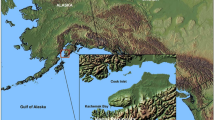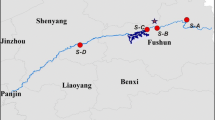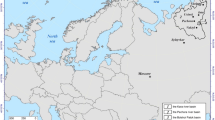Abstract
Planned harbor expansion and industrial developments may adversely affect the economically important aquatic resources of the lower Savannah River, including those at the Savannah National Wildlife Refuge. To establish the present level of chemical contamination in this system, we collected a total of 102 samples of nine species of fish and fiddler crabs (Uca pugilator) from eleven sites in the lower Savannah River and on the Savannah National Wildlife Refuge, and analyzed them for concentrations of organochlorine chemicals, aliphatic and aromatic petroleum hydrocarbons, and 13 elemental contaminants: aluminum, arsenic, cadmium, chromium, cobalt, copper, iron, lead, manganese, mercury, nickel, selenium, and zinc. Residues of DDT (mainly as DDE),trans-nonachlor, dieldrin, Aroclor® 1260, mirex, and petroleum hydrocarbons were common in fish from the lower Savannah River, but concentrations were below those warranting environmental concern. In general, the concentrations of elemental contaminants also were low; however, arsenic, cadmium, and chromium concentrations were elevated in fish from river stations near the city of Savannah, and lead was elevated in samples from the National Wildlife Refuge. Contamination of the lower Savannah River by organic and elemental contaminants, as indicated by concentrations in fishes and fiddler crabs, did not appear to pose a hazard.
Similar content being viewed by others

References
Abernathy AR, Cumbie PM (1977) Mercury accumulation by large-mouth bass (Micropterus salmoides) in recently impounded reservoirs. Bull Environ Contain Toxicol 17:595–602
Aguilar A (1984) Relationship of DDE/DDT in marine mammals to the chronology of DDT input into the ecosystem. Can J Fish Aquatic Sci 41:840–844
Anderson JW, Neff JM, Cox BA, Tatem HE, Hightower GM (1974) Characteristics of dispersion and water soluble extracts of crude and refined oils and their toxicity of estuarine crustaceans and fish. Mar Biol 27:75–88
Atchison GJ, Murphy BR, Bishop WE, McIntosh AW, Mayes RA (1977) Trace metal contamination of bluegill (Lepomis macrochirus) from two Indiana lakes. Trans Am Fish Soc 106:637–640
Baker JP, Schofield CL (1982) Aluminum toxicity to fish in acidic waters. Water Air Soil Pollut 18:289–310
Baumann PC, Harshbarger JC (1985) Frequences of liver neoplasia in a feral fish population and associated carcinogens. Mar Environ Res 17:324–327
Baumann PC, Smith WD, Parland WK (1987) Tumor frequencies and contaminant concentrations in brown bullheads from an industrialized river and a recreational lake. Trans Am Fish Soc 116:79–86
Baumann PC, Smith WD, Ribick M (1982) Hepatic tumor rates and polynuclear aromatic hydrocarbon levels in two populations of brown bullhead (Ictalurus nebulosus). Pages 93–102 In: Cooke MW, Dennis AJ, Fisher GF (eds) Polynuclear aromatic hydrocarbons: sixth international symposium on physical and biological chemistry, Battelle Press, Columbus, Ohio
Benville PE, Whippel JA, Eldridge MB (1985) Acute toxicity of seven alicyclic hexanes to striped bass,Morone saxatilis, and bay shrimp,Crangon franciscorum, in seawater. Calif Fish Game 71:132–140
Berg DJ, Burns TA (1985) The distribution of aluminum in the tissue of three fish species. J Freshwat Ecol 3:113–120
Bradley RW, Sprague JB (1985) Accumulation of zinc by rainbow trout as influenced by pH, water hardness and fish size. Environ Toxicol Chem 4:685–694
Brumbaugh WG, Kane DA (1985) Variability of aluminum concentrations in organs and whole bodies of smallmouth bass (Micropterus dolomieui). Environ Sci Technol 19:828–831
Buckler DR, Witt A Jr, Mayer FL, Huckins JN (1981) Acute and chronic effects of Kepone® and mirex on the fathead minnow. Trans Am Fish Soc 110:270–280
Buhler DR, Stokes RM, Caldwell RS (1977) Tissue accumulation and enzymatic effects of hexavalent chromium in rainbow trout (Salmo gairdneri). J Fish Res Board Can 34:9–18
Burdick GE, Harris EJ, Dean JH, Walker TM, Skea J, Colby D (1964) The accumulation of DDT in lake trout and the effect on reproduction. Trans Am Fish Soc 93:127–136
Crecelius EA, Augenfeld JM, Woodruff DL, Anderson JW (1980) Uptake of trace metals by the clamMacoma inquinata from clean and oil-contaminated detritus. Bull Environ Contam Toxicol 25:337–344
Czarnezki JM (1985) Accumulation of lead in fish from Missouri streams impacted by lead mining. Bull Environ Contam Toxicol 34:736–745
Demayo A, Taylor MC, Taylor KW, Hodson PV (1982) Toxic effects of lead and lead compounds on human health, aquatic life, wildlife, plants, and livestock. CRC Critical Reviews in Environ Control 12:257–306
Doudoroff P, Katz M (1953) Critical review of literature on the toxicity of industrial wastes and their components to fish. II. The metals, as salts. Sew Ind Wastes 25:802–839
Dudley RG, Mullis AW, Terrell JW (1977) Movements of adult striped bass (Morone saxatilis) in the Savannah river, Georgia. Trans Am Fish Soc 106:314–322
Eisler R (1985a) Mirex hazards to fish, wildlife, and invertebrates: a synoptic review. US Fish Wildl Serv Biol Rep 85(1.1), Patuxent Wildl Res Center, Laurel, Maryland, 42 pp
— 1985b. Cadmium hazards to fish, wildlife, and invertebrates: a synoptic review. US Fish Wildl Serv Biol Rep 85(1.2), Patuxent Wildl Res Center, Laurel, Maryland, 46 pp
— (1985c) Selenium hazards to fish, wildlife, and invertebrates: a synoptic review. US Fish Wildl Serv Biol Rep 85(1.5), Patuxent Wildl Res Center, Laurel, Maryland, 57 pp
— (1986a) Chromium hazards to fish, wildlife, and invertebrates: a synoptic review. US Fish Wildl Serv Biol Rep 85(1.6), Patuxent Wildl Res Center, Laurel, Maryland, 60 pp
— (1986b) Polychlorinated biphenyl hazards to fish, wildlife, and invertebrates: a synoptic review. US Fish Wildl Serv Biol Rep 85(1.7), Patuxent Wildl Res Center, Laurel, Maryland, 72 PP
— (1987a) Mercury hazards to fish, wildlife, and invertebrates: a synoptic review. US Fish Wildl Serv Biol Rep 85(1.10), Patuxent Wildl Res Center, Laurel, Maryland, 90 pp
— (1987b) Polycyclic aromatic hydrocarbon hazards to fish, wildlife, and invertebrates: a synoptic review. US Fish Wildl Serv Biol Rep 85(1.11), Patuxent Wildl Res Center, Laurel, Maryland, 81 pp
Elwood JW, Beauchamp JJ, Allen CP (1980) Chromium levels in fish from a lake chronically contaminated with chromates from cooling towers. Internat J Environ Stud 14:289–298
Regal AR, Martin JH (1977) Contamination of biological samples by ingested sediment. Mar Pollut Bull 8:90–92
Forstner U, Prosi F (1979) Heavy metal pollution in freshwater ecosystems. In: Ravera O (ed) Biological Aspects of Freshwater Pollution, Pergamon Press, Oxford
Gale NL, Wixson BG (1986) Fish from Missouri's lead belt: To eat or not to eat. Environ Geochem Health 8:3–10
Giesy JP Jr, Wiener JG (1977) Frequency distribution of trace metal concentrations in five freshwater fishes. Trans Am Fish Soc 106:393–403
Gillespie RB, Baumann PC (1986) Effects of high tissue concentrations of selenium on reproduction by bluegills. Trans Am Fish Soc 115:208–214
Goodyear CP, Boyd CE (1972) Elemental composition of largemouth bass (Micropterus salmoides). Trans Am Fish Soc 101:545–547
Grahn O (1980) Fish kills in two moderately acid lakes due to high aluminum concentration. In: Drablos D, Tollan A (eds) Ecological impact of acid precipitation, Proc Internat Conf, Sandefjord, Norway, March 1980
Hildebrand GG, Strand RH, Huckabee JW (1980) Mercury accumulation in fish and invertebrates of the North Fork Holston River, Virginia and Tennessee. J Environ Qual 9:393–400
Hites RA, LaFlamme RE, Farrington JW (1977) Sedimentary polycyclic aromatic hydrocarbons: The historical record. Science 198:829–831
Hunt WG, Johnson BS, Thelander CG, Walton BJ, Risenbrough RW, Jarman WM, Springer AM, Monk JG, Walker II W (1986) Environmental levels ofp,p′-DDE indicate multiple sources. Environ Tbxicol Chem 5:21–27
Hunter RG, Carroll JH, Butler JS (1981) The relationship of trophic level to arsenic burden in fish of a southern Great Plains lake. J Freshwat Ecol 1:121–127
Ishak MM, Khalil SR, Abdelmalik WEY (1977) Distribution and tissue retention of cesium-134 and cobalt-60 in the Nile catfishClarias lazera. Hydrobiologia 54:41–48
Jenkins DW (1980) Nickel accumulation in aquatic biota. Pages 283–337 In: Nriaqu JO (ed) Nickel in the environment. John Wiley and Sons, New York
Joyner SP (ed) (1985) SAS/STAT guide for personal computers. version 6 edition. SAS Institute Inc, Cary, NC, 378 pp
Karlsson-Norrgren L, Bjorklund I, Ljungberg O, Runn P (1986) Acid water and aluminum exposure: Experimentally induced gill lesions in brown trout,Salmo trutta L. J Fish Disease 9:11–26
Kelso JRM, Frank R (1974) Organochlorine residues, mercury, copper, and cadmium in yellow perch, white bass and smallmouth bass, Long Point Bay, Lake Erie. Trans Am Fish Soc 103:577–581
Knoll J, Fromm PO (1960) Accumulation and elimination of hexavalent chromium in rainbow trout. Physiol Zool 33:1–8
Larsen PF, Gadbois DF, Johnson AC (1986) Polycyclic aromatic hydrocarbons in Gulf of Maine sediments: distribution and mode of transport. Mar Environ Res 18:231–244
Lowe TP, May TW, Brumbaugh WG, Kane DA (1985) National contaminant biomonitoring program: Concentrations of seven elements in freshwater fish, 1978–1981. Arch Environ Contam Toxicol 14:363–388
Lucas JF Jr, Edgington DN, Colby PJ (1970) Concentrations of trace elements in Great Lakes fishes. J Fish Res Board Can 27:677–684
Mertz W (1981) The essential trace elements. Science 213:1332–1338
Murphy BR, Atchison GJ, McIntosh AW, Kolar DJ (1978) Cadmium and zinc content of fish from an industrially contaminated lake. J Fish Biol 13:327–335
Oguri M (1976) On the enlarged liver in “cobalt” variant of rainbow trout. Bull Jpn Soc Sci Fish 42:823–830
Ohlendorf HM, Hoffman DJ, Saiki MK, Aldrich TW (1986) Embryonic mortality and abnormailities of aquatic birds: Apparent impacts of selenium from irrigation drainwater. Sci Total Environ 52:49–63
Pakkala IS, Gutenmann WH, Lisk DJ, Burdick GE, Harris EJ (1972) A survey of the selenium content of fish from 49 New York State waters. Pest Monit J 5:348–355
Phillips FR, Russo RC (1978) Metal bioaccumulation in fishes and aquatic invertebrates: A literature review. US Environ Prot Agency, Duluth, MN, EPA-600-78-103, 115 pp
Pittinger CA, Buikema AL Jr, Falkinham JO, III (1987)In situ variations in oyster mutagenicity and tissue concentrations of polycyclic aromatic hydrocarbons. Environ Toxicol Chem 6:51–60
Sandholm M, Oksansen HE, Pesonen L (1973) Uptake of selenium by aquatic organisms. Limnol Oceonogr 18:496–499
Schmitt CJ, Ribick MA, Ludke JL, May TW (1983) National pesticide monitoring program: Organochlorine residues in fresh-water fish, 1976–79. US Dept Int, Fish Wildl Serv, Resour Publ 152, Washington, D.C., 62 pp
Schmitt CJ, Zajicek JL, Ribick MA (1985) National pesticide monitoring program: Residues of Organochlorine chemicals in fresh-water fish, 1980–81. Arch Environ Contam Toxicol 14:225–260
Spehar RL, Fiandt JR, Anderson RL, Defoe DL (1980) Comparative toxicity of arsenic compounds and their accumulation in invertebrates and fish. Arch Environ Contam Toxicol 9:53–64
Steel RGD, Torrie JH (1980) Principles and procedures of statistics, 2nd edition. McGraw-Hill, New York
Tollefson L, Cordle F (1986) Methylmercury in fish: A review of residue levels, fish consumption and regulatory action in the United States. Environ Health Perspect 68:203–208
Uthe JF, Bligh EG (1971) Preliminary survey of heavy metal contamination of Canadian fish. J Fish Res Board Can 28:786–789
Uthe JF, Chou CL (1987) Cadmium in sea scallops (Placopecten magellanicus) tissues from clean and contaminated areas. Can J Fish Aquatic Sci 44:91–98
Uthe JF, Musial CJ (1986) Polycyclic aromatic hydrocarbon contamination of American lobster,Homarus americanus, in the proximity of a coal-coking plant. Bull Environ Contam Toxicol 37:730–738
Wageman R, Snow NB, Rosenberg DM, Lutz A (1978) Arsenic in sediments, water and aquatic biota from lakes in the vicinity of Yellowknife, Northwest Territories, Canada. Arch Environ Contam Toxicol 7:169–191
White DH, Krynitsky AJ (1986) Wildlife in some areas of New Mexico and Texas accumulate elevated DDE residues, 1983. Arch Environ Contam Toxicol 15:149–157
Wiener JG, Jackson GA, May TW, Cole CP (1984) Longitudinal distribution of trace elements (As, Cd, Cr, Hg, and Se) in fishes and sediments in the Upper Mississippi River. Butterworth Publ, Stoneham, MA
Winger PV, Sieckman C, May TW, Johnson WW (1984) Residues of Organochlorine insecticides, polychlorinated biphenyls, and heavy metals in biota from Apalachicola River, Florida, 1978. J Assoc Offic Anal Chem 67:325–333
Woodward DF, Mehrle PM, Mauck WL (1981) Accumulation and sublethal effects of a Wyoming crude oil in cutthroat trout. Trans Am Fish Soc 110:437–445
Wren CD (1986) A review of metal accumulation and toxicity in wild mammals. 1. mercury. Environ Res 40:210–244
Author information
Authors and Affiliations
Rights and permissions
About this article
Cite this article
Winger, P.V., Schultz, D.P. & Johnson, W.W. Environmental contaminant concentrations in biota from the lower Savannah River, Georgia and South Carolina. Arch. Environ. Contam. Toxicol. 19, 101–117 (1990). https://doi.org/10.1007/BF01059818
Received:
Revised:
Issue Date:
DOI: https://doi.org/10.1007/BF01059818



